InterviewSolution
This section includes InterviewSolutions, each offering curated multiple-choice questions to sharpen your knowledge and support exam preparation. Choose a topic below to get started.
| 2201. |
A line in 3-dimensional space makes an angle theta(0ltthetalepi//2) with both x and y-axis. Then the set of all values of theta is the interval: |
|
Answer» `(0,(pi)/(4)]` |
|
| 2202. |
Solve graphically x + y ge 1 |
Answer» SOLUTION :
|
|
| 2203. |
If (2,0),(0,1),(4,5)and (0,c) are concy- clic, and then find c. |
|
Answer» |
|
| 2204. |
A particle which is moving along x-axis has acceleration at any time t like a(t)=(12t^2-30t)m//s^2.At t=0, velocity of particle is 7 m/s and at t=1 sec, particle is at x=6m. Choose the CORRECT function for position at any time t. |
|
Answer» `x=t^4-5t^3+7t+3` |
|
| 2205. |
Indicate the relation which is true: |
|
Answer» `TAN|tan^(-1)x|=|x|` |
|
| 2206. |
Evalute the following integrals int x^(2) " sin "x^(3)dx |
|
Answer» |
|
| 2207. |
-N = O group can show |
|
Answer» `+M` EFFECT |
|
| 2208. |
Using elementry transformation, find the inverse of the matrices. A = [(7,-10),(-2,3)] |
| Answer» SOLUTION :`A^(-1) = [(7,-10),(-2,3)]` | |
| 2209. |
Two mutually exclusive events having nonzero probabilities of occurrence cannot be ________? |
|
Answer» <P> |
|
| 2211. |
Let veca = 2hati+hatj, vecb = -hati+3hatj+hatk and vecc = hati+2hatj+5hatk be three vectors. Find vecaxx(-vecb) |
Answer» SOLUTION :
|
|
| 2212. |
State with reason, "All finite subsets of the set Z of integers " is set or not ? |
| Answer» SOLUTION :It is a SET, as it is WELL DEFINED. | |
| 2213. |
Write thevectorequationsof each ofthe followinglinesand hencedeterminethe distance betweenthem: (x-1)/(2)=(y-2)/(3)=(z+4)/(6)" and" (x-3)/(4) =(y-3)/(6)=(z+5)/(12) |
|
Answer» `L_(2) : vec(r ) =(3hat(i) + 3hat(j) -5hat(k))+ 2mu (2hat(i) +3hat(j) +6hat(k))` Now FIND thedistancebetweenthe PARALLELLINES `L_(1)" and" L_(2)` |
|
| 2214. |
If every pair from among the equations x^(2)+px +qr=0, x^(2)+qx +rp=0 and x^(2)+rx +pq=0 has a common root, then the sum of the three common roots is |
|
Answer» `2(p+q+r)` |
|
| 2215. |
A clrcle whose centre lies on the hyperbola (x ^(2))/(a ^(2)) + (y ^(2))/(b ^(2)) =1intersects the rectangular hyperboal xy = c ^(2) in four points. Show that the locus of the centre of the locus of the centroid of triangle formed by any three points of intersectivon is (x ^(2))/(a^(2)) - (y ^(2))/(b ^(2)) = ((2)/(3)) ^(2). |
|
Answer» |
|
| 2216. |
If A,B are two events such that P(A)=0.3, P(B)=0.4,P(AcupB)=0.6 Find P(B | A) |
|
Answer» <P> SOLUTION :`P(B/A)=(P(ACAPB))/(P(A))=0.1/0.3=1/3` |
|
| 2217. |
The real number k for which the equation, 2x^(3) + 3x + k = 0 has two distinct real roots in [0,1] |
|
Answer» LIES between -1 and 0 |
|
| 2218. |
Find the second order derivatives of the function e^(x) sin 5x. |
|
Answer» |
|
| 2219. |
The relation R={(1,1),(2,2),(3,3)} on the set {1, 2, 3) is |
|
Answer» SYMMETRIC only |
|
| 2220. |
Find the number of ways of arranging the letters of the word. PERMUTATION |
|
Answer» |
|
| 2222. |
If the line (x-1)/(2)=(y-1)/(3)=(z+2)/(2) lies in the plane x+By-3z+D=0, then the values of B and D are |
|
Answer» `(4)/(3),(-25)/(3)` |
|
| 2223. |
Evaluate the following integrals. int(x+2)sqrt(x+1)dx |
|
Answer» |
|
| 2224. |
If the roots of ax^(2)+ax+c=0are in the ratio p : q, then sqrt((p)/(q)) +sqrt((q)/(p))=0 |
|
Answer» `SQRT((a^(2))/(c ))` |
|
| 2225. |
What is the smallest positive integer t such that threre exist integer n_1,n_2 .....n_1 with (n_1^3+n_2^3+......+n_1^3=4000^(4000)) |
|
Answer» |
|
| 2226. |
3x^(2) - 5x+2 5x^(2) - 2x -6 Which of the following is the sum of the two polynomials shown above? |
|
Answer» `8X^(2) -7X -4` |
|
| 2227. |
A cottage industry manufactures pedestal lamps and wooden shades, each requiring the use of a grinding/ cutting machine and a sprayer. It takes 2 hours on grinding/cutting machine and 3 hours on the sprayer to manufacture a pedestal lam. It takes 1 hour on the grinding/cutting machine and 2 hours on the sprayer to manufacture a shade. On any day, the sprayer is available for at the most 20 hour and the grinding/ cutting machine for at the most 12 hours. The profit from the sale of a lamp is Rs. 5 and that from a shade isRs. 3. Assuming that the manufacturer can sell all the lamps and shadesthat the produces how should be scehdule his daily production in order to maximise his profit? |
Answer» Solution :Let the MANUFACTURE makes `x` pedestal lamps and `y` wooden shades per day then 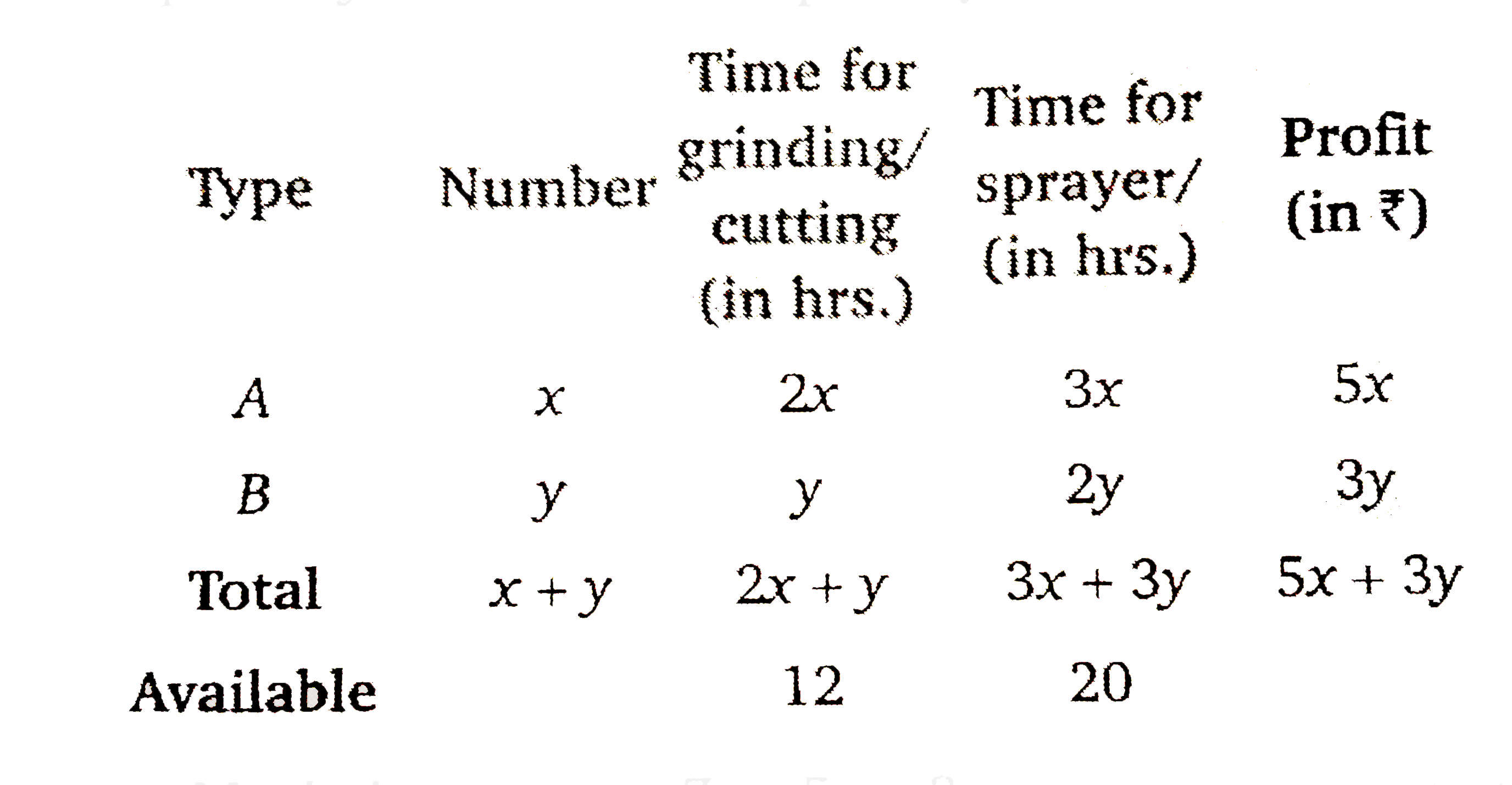 Maximise `Z=5x+3y`…………. 1 Constraints `2x+yle12`…………………2 `3x+2yle20`………………..3 `xge0,yge0`………………….4 First, draw the graph of the equation `2x+y=12` 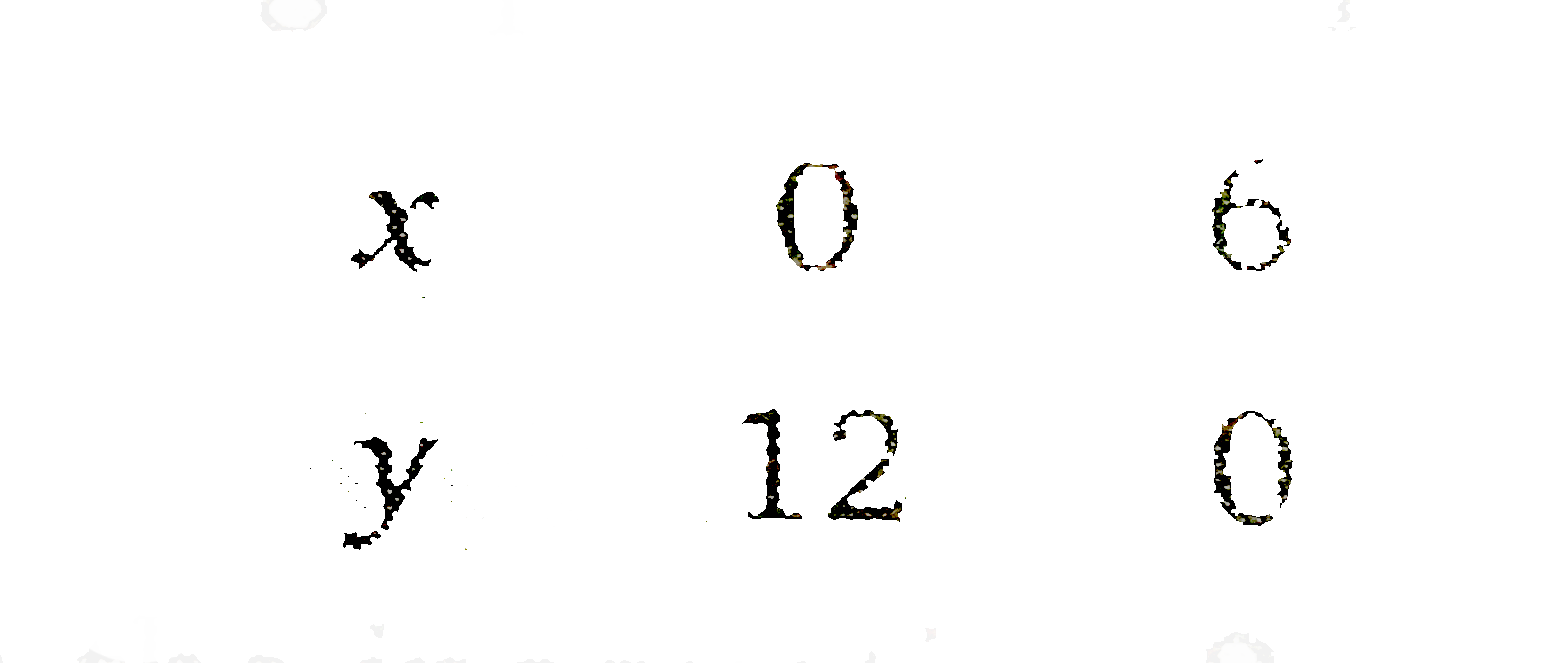 Put `(0,0)` in the inequation `2x+yle12`, `2xx0+0le12` `0le12` (True) THEREFORE, half plane contain the origin. Since `x,yge0` Therefore FEASIBLE region will be in first quadrant. Now, draw the graph of the line `3x+2y=20` 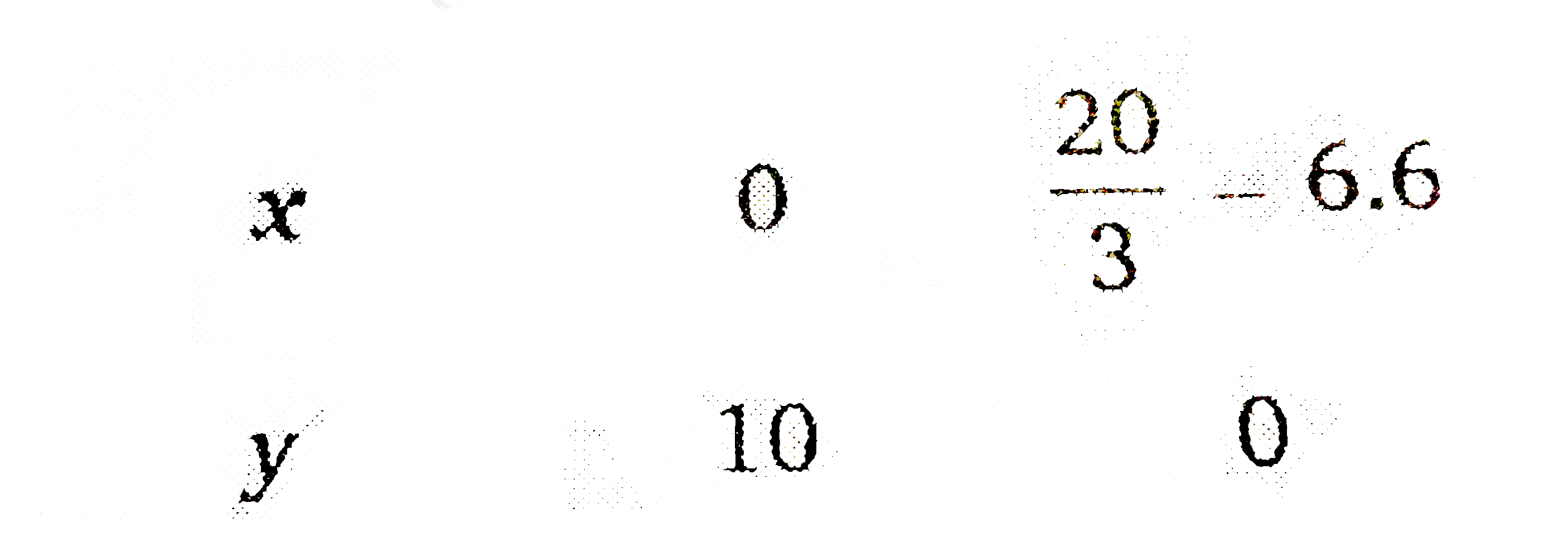 Put `(0,0)` in the inequation `3x+2yle20` `3xx0+2xx0le20implies0le20` (True) Therefore half plane contains the origin. 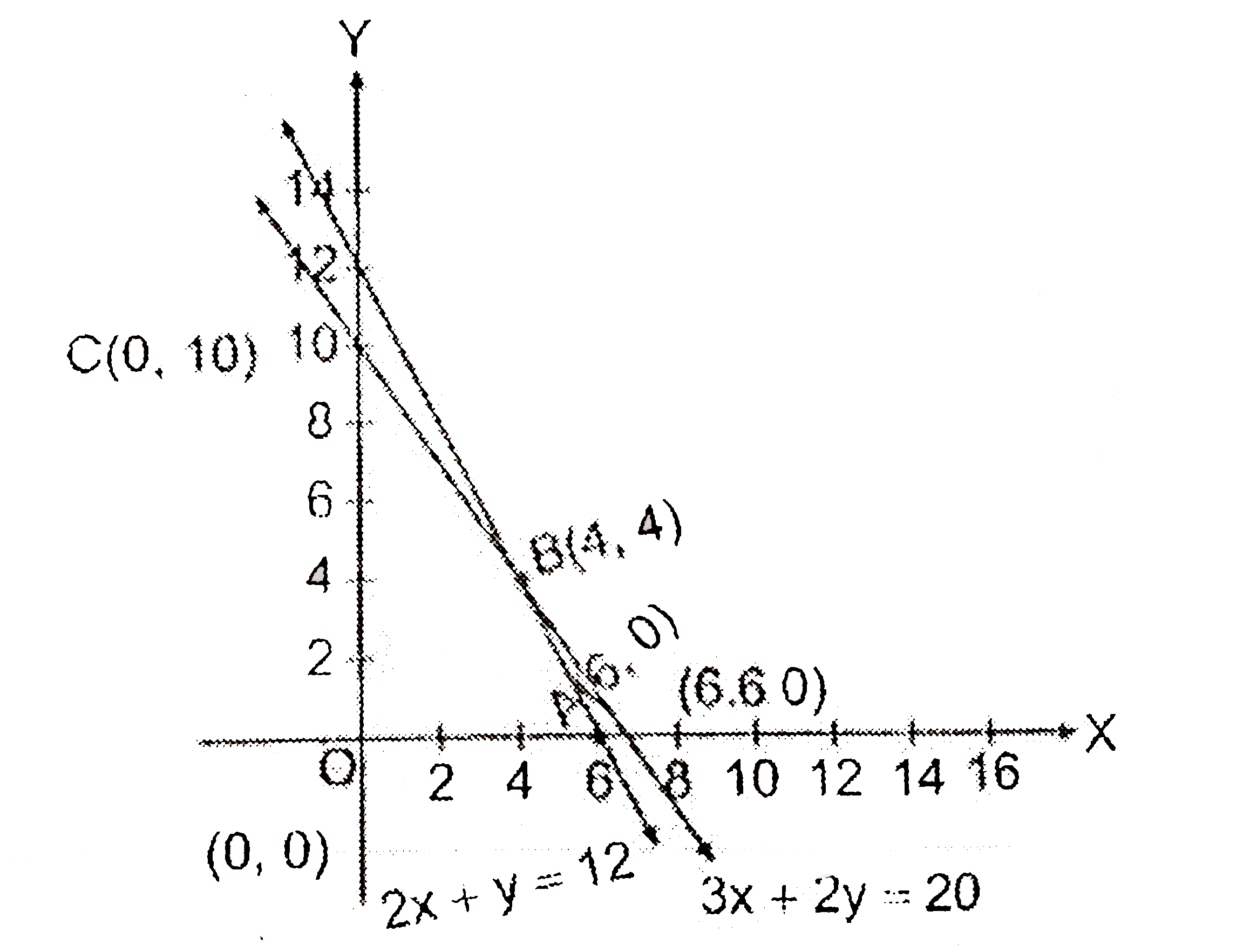 From equations `2x+y=12` and `3x+2y=20` The point of intersection is `B(4,4)` Therefore the feasible region is OABCO. Its vertices are `O(0,0),A(6,0),B(4,4)` and `C(0,10)` we FIND the value of `Z` at these vertices. 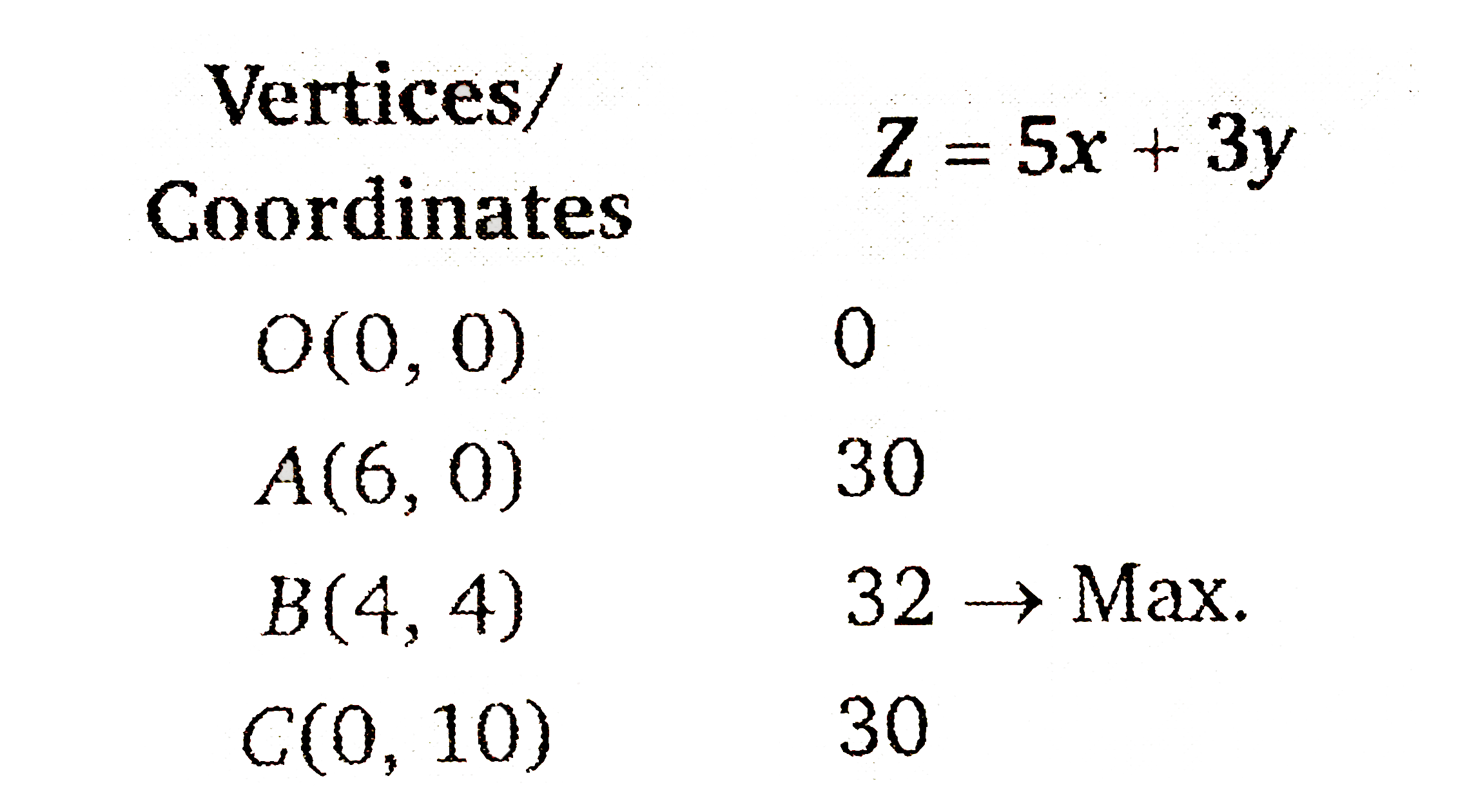 The maximum value of `Z` is Rs. 32 at point `B(4,4),`. Therefore 4 pedestal LAMP and 4 wooden shade should be made the manufacturer to obtain the maximum profit. |
|
| 2228. |
If alpha, beta are roots of ax^(2) + bx + c =0 , a cancel(=) 0 and alpha + beta, alpha^(2) + beta^(2) , alpha^(3) + beta^(3)are in G.P. and delta be the discriminant, then : |
| Answer» Answer :C | |
| 2229. |
y=ae^(x), y=be^(-x) intersect at right angles if ……….. (a ne 0, b ne 0) |
|
Answer» `a=(1)/(B)` |
|
| 2230. |
If A={1,3,5,7,9,11,13,15,17},B={2,4,…..,18} and N is the universal set, then A'uu((A uu B)nn B') is |
|
Answer» A |
|
| 2231. |
Uing cofactors of elements of first row evaluate |{:(2,-1,3),(6,4,16),(8,5,8):}| |
|
Answer» |
|
| 2232. |
If x^2 -hx - 21 = 0 and x^2 - 3hx + 35 =0 ( h gt 0) have a common roots, then h =………….. |
| Answer» Answer :C | |
| 2234. |
Integers 1.2.3........n where n gt 2 , are written on a board. Two numbers m, k such that 1 ltm ltn, 1 ltkltnare removed and the average of the remaining numbers is found to be 17. What is the maximum sum of the two removed numbers ? |
|
Answer» |
|
| 2235. |
If a circle cuts the parabola y^(2)=4ax in four points then the algebraic sum of ordinates of the four points is |
|
Answer» 0 |
|
| 2236. |
Find the number of all one-one functions from set A = {1, 2, 3} to itself. |
|
Answer» |
|
| 2237. |
Let the matrices A=[{:( sqrt3,-2),(0,1):}] and P be any orthogonal matrix such that Q = PAP and let Rne [r_0] _(2-2)=P'Q^(6) Pthen |
|
Answer» `r_(11) =81 ` |
|
| 2238. |
The vertices of Delta ABC are A(2,4) B(-4, 2) and C(0,0). Find the slopes of AC and AB. |
|
Answer» |
|
| 2239. |
If the coefficients of the r^(th) term and the (r + 1)^(th) term in the expansion of (1 + x)^(20) are in the ratio 1:2, then r is equal to |
|
Answer» 6 |
|
| 2240. |
Ifa_(0),a_(1),a_(2) ,…, a_(2n) are the coefficients in the expansion of(1 + xx^(2))^(n)in ascending of x show thata_(0)^(2) - a_(1)^(2) - a_(2)^(2) -…+ a_(2n)^(2) = a_(n) . |
|
Answer» Solution :We have , `(1 + x + x^(2))^(N) = a_(0) + a_(1)x + a_(2)x^(2) + a_(2n) x^(2n)` …(i) Replacing x by in Eq. (i), we get ` (1 - (1)/(x) + (1)/(x^(2)))^(n)= a_(0) - (a_(1))/(x) + (a_(2))/(x^(2)) - ...+ (a_2n)/(x^(2n))` ...(II) On multiplyingEqs.(i) and (ii) , we get `(1 + x + x^(2))^(n)XX (1 - (1)/(x) + (1)/(x^(2)))^(n)= (a_(0) + a_(1)x + a_(2)x^(2)+ ...+ a_(2n)x^(2n) )xx(a_(0) - (a_(1))/(x) + (a_(2))/(x^(2))- ...+ (a_(2n))/(x^(2n)))` `rArr ((1 + x^(2) + x^(2))^(n))/(x^(2n))= (a_(0) + a_(1)x + a_(2)x^(2)+ ...+ a_(2n)x^(2n) )xx(a_(0) - (a_(1))/(x) + (a_(2))/(x^(2))- ...+ (a_(2n))/(x^(2n)))` ...(iii) Constant term in RHS ` = a_(0)^(2) - a_(1)^(2) + a_(2)^(2)- ...+ a_(2n)^(2)` Now, constant term in` ((1 + x^(2) + x^(4))^(n))/(x^(2n) )= `Coefficient of ` x^(2n)` in ` (1 + x^(2) + x^(4))^(n) = a_(n)` [replacing x by ` x^(2)` in Eq.(i) ] But Eq.(iii) is an identity , therefore , the constant term in RHS = constant term in LHS . `a_(0)^(2) - a_(1)^(2) + a_(2)^(2) - ...+ a_(2n)^(2) = a_(n)`. |
|
| 2241. |
Integration using rigonometric identities : (d)/(dx)g(x)=g(x) and g(0)=1 then int g(x)((2-sin 2x)/(1-cos2x))dx....+c |
| Answer» Answer :B | |
| 2242. |
int_(1)^(3) (sqrt(3))/(sqrt(4-x)+sqrt(x))dx= |
|
Answer» 1 |
|
| 2243. |
The vector with magnitude 17sqrt(2) and in the opposite direction of (0,1,-1) is ………….. |
|
Answer» `17sqrt(2)(0,1,-1)` |
|
| 2244. |
A card is picked at rnadomfrom a pack of 52 playing cards. Given that the picked card is a queen , the probability of this card to be a card of hearts is |
|
Answer» `1/3` |
|
| 2245. |
The probability that in a family of 5 children there will be atleast a girl is |
| Answer» Answer :D | |
| 2246. |
{:(Column-I,Column-II),((A)"Number of solution of the equation"sqrt(x+6)=x "is",(P)1),((B)"The number of integral pair"(s)(x,y) "whose sum is equal to",(Q)2),("their product is",),((C)x=(1)/(sqrt(2-3))and y=(1)/(sqrt(2+3))"then the value of" (x-y)^(2)"equals",(R)3),({:("Let" x=1+ ul(""1"")),(""2+ul(""1"")),(""1+ul(""1"")),(""2+ul(" "1"")),(""1+ul(" "1"")),(""2+............):},):} |
|
Answer» <P> |
|
| 2247. |
Let theequaiton of a ray be |z-2|-|z-1-i| = sqrt(2). If theis strik the y-axis, then the equation of relfected ray (including or excludingthepointof incidence) is . |
|
Answer» `arg(z-2i)=(pi)/(4)` This ray is EMANATING FORM thepoint '2' and moving totheleft of '2' . It strikes y-axis at POINT 2i.  Then equation of reflected of reflected ray is `arg(z-2i)=(pi)/(4)` or `|z-2i|-|z-3-i| = sqrt(2)` |
|
| 2248. |
Integrate the function is Exercise. (sin^(-1) sqrt(x)-cos^(-1)sqrt(x))/(sin^(-1) sqrt(x)+cos^(-1) sqrt(x)), x in [0,1] |
|
Answer» |
|
| 2249. |
Solve graphically x + 8y+10>0 |
Answer» SOLUTION : 
|
|
| 2250. |
A variable tangent to the parabola y^(2)=4ax meets the parabola y^(2) +4ax=0 at the points P,Q . The locus of the middle point of PQ is |
|
Answer» `y^(2)+4ax=0` |
|